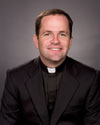Believing in what you can't see
More than one person has asked, "If I go to Church this Sunday, will it count for both Sunday and Christmas?" My response has been, "good try, but no. We have to go twice - the 4th Sunday of Advent (12/24) and Christmas". Christmas is a Holy Day of Obligation.
------------------------------------
Christine Regan wrote, "I was talking about the Eurcharist with Elizabeth after Confirmation and I told her my personal way of believing in the Real Presence of Christ in the Eucharist. I know it's a little sacrilegious, but I always liked to compare the concept of believing in the Eucharist to a scene from 'The Santa Clause' with Tim Allen. It's the scene when a psychologist is trying to convince the little boy, Nick, that Santa Claus isn't real, when Nick truly believes that he is. Nick challenges the psychologist, asking, 'have you ever seen a million dollars?' The psychologist answers 'no'. Nick responds 'Seeing is not believing. Just because you can't see it, doesn't mean it's not real.' I always thought that was a perfect explanation for belief in the Eucharist, and in God in general."
Thanks, Christine, for your comment. As you said, it's not a perfect example but the main point is a good one. Also, it is very good that you have your Christian "radar" up when viewing movies or any kind of media. In other words, you are applying what you see and hear from the world in relation to Christ. To have your "Eucharist radar" up when seeing this movie is an even better sign!
At Thanksgiving, I had a very profound conversation with my 12 year old niece about seeing and believing. She is an intelligent girl who has a passionate heart. We were talking specifically about the Eucharist, and she made it clear that she struggles to believe in what she can't see, like so many people do. I offered a few examples to her that would show that she does believes in things every day that she can't see.
I brought up the example of drinking soda out of a can. I asked her if she can see the soda inside the can before she opens it. She said that she doesn't drink soda. Oh. So, we went to the example of soup which she does eat. Ok. So, you have an unopened can of soup. Let's say it's labeled as tomato soup on the outside of the can. How does she know that it's tomato soup? She can't see what's inside. She doesn't know; she BELIEVES that it's tomato soup. Before we open a can of tomato soup or a can of Coke, we can't see what's inside, but we do believe (it's tomato soup or Coke). The can says it is and that is the evidence we use to believe that it is true.
After a few other mundane examples, I asked her if she believes in love? In other words, does love exist? "Yes". Can you see it? "No". Then, why do you believe it exists if you can't see it? We agreed that it's because she has had an experience of love, or at least that she has experienced something that many, many people have experienced, and we call it love. We can't see it but there is overwhelming evidence that it exists. So, we believe that it is real.
These examples are usually employed to help people believe in God, as you suggested, Christine, because we cannot see God. But they can be applied specifically to the Eucharist or to any of the sacraments (which are all signs of the Presence of God on Earth). We don't see a change in the bread and wine but there is overwhelming evidence from Sacred Scripture and Tradition that it becomes the Body, Blood, Soul, and Divinity of Jesus Christ. The first and most compelling piece of evidence is that Jesus says it: "this is my body". We can't see that it's his Body, but because He has told us, we believe it.


1 Comments:
This comment has been removed by a blog administrator.
Post a Comment
<< Home